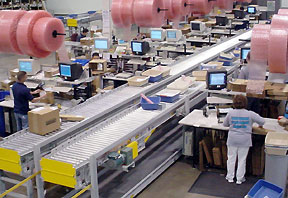Smart Labor Management Helps Cut Warehouse Costs
Reduce labor distribution center labor costs without massive capital investments

It’s important to control costs in your operation. What are some warehousing cost-cutting methods you can employ that don’t require extensive investment or re-tooling? Most of the costs of warehousing operations fall into the following categories:
- People
- Real Estate, Utilities & other Fixed Costs
- Inventory
- Technology
This week, we will focus on labor-force aspects of cost reduction. These are often low-cost, low-effort changes almost any operation can undertake to improve.
 Train (and cross-train) thoroughly
Train (and cross-train) thoroughly
In many operations, it’s difficult to retain qualified workers, but training can help you make the ones you have better. Trained employees make fewer mistakes, work harder, and don’t damage equipment and inventories. They can run forklifts, walkies, conveyors, order pickers, stackers, and other machinery safer and more efficiently. People who are given regular training feel more valued, and are less likely to jump elsewhere for a 50 cent per hour raise. Even as you lose people, training insulates your operation from many errors and motivates your people.
Reconsider roles & processes, then restructure
Labor is typically a distribution center’s most expensive line item, so staffing isn’t something you can autopilot. Many operations allow a mishmash of processes, policies, and people to exist essentially by inertia. A labor analysis that repositions people into an integrated process can create efficiency in line and support positions. By re-evaluating the entire operation – what it does, and how – you’ll uncover redundant activities, needless extra steps, and inefficient activities. You’ll be able to implement changes that may increase quality and reduce headcount with minimal cost and pain.
Find out what your best performers do and copy it
Every operation has those top-tier workers who outperform the rest. The guy who packs more orders, picks them better, and almost always gets it right isn’t always just sharper or more motivated. He might be working smarter. Left on their own, workers will often discover productivity enhancements that managers won’t. Find these improvements and integrate them. What do your best people do that others don’t? Find out and push that improvement to everyone. Let the picker who is faster run seminars on how he does it. Take video and archive it. Turn “tribal knowledge” into a business asset.
Go through the motions
As mentioned above, methods are vital. Do you pay attention to the exact ways people execute tasks and teach the best way? What order are things done in packing, picking, restocking, and other common operations? Is there a better way? You won’t know until you study what’s happening now. Old fashioned motion studies have fallen from favor in recent years, and people are frequently left to their own devices when it comes to figuring out how to execute specific tasks. You can squeeze out additional productivity in small increments across your entire operation. Understanding how much time a task should take lets you measure and improve. You’ll know the acceptable ranges so you can correct under-performers and offer incentives to achievers.
Screen temp workers like full-time hires
During seasonal spikes or other high-demand times, you’ll often need temp workers to keep up with demand. It’s easy to take on the people who the staffing agency sent you without much attention to detail, but that can result in a poor fit. Do they fit your company’s culture and standards? Can they communicate effectively with the people around them? Spending time and being selective can help you avoid problems across the board. Screen them to avoid turnover, conflicts, and mistakes at a critical time. This also helps you reduce training time and costs. It may also help you identify temps you might want to hire full-time at a later date.
Go ergonomic to increase labor flexibility
Robroy, one of our clients, has worked hard to achieve ergonomics in every aspect of its operation. Besides reducing the costs related to back strains and injuries, Robroy got another benefit: it doubled the available labor pool for most of its tasks by implementing lifts, jib cranes, and balancers. If a piece of your operation requires a heavy lift, you have essentially reduced the labor pool to those who can lift a heavy load. For almost all of these tasks, there are ways to shift the burden onto machinery so that the pool of available labor grows while the costs related to injuries drops.
Tags: ergonomics, ROI, labor management, LCS, Warehouse Management, Automation, employees
Scott Stone is Cisco-Eagle's Vice President of Marketing with 35 years of experience in material handling, warehousing and industrial operations. His work is published in multiple industry journals an websites on a variety of warehousing topics. He writes about automation, warehousing, safety, manufacturing and other areas of concern for industrial operations and those who operate them.




 Train (and cross-train) thoroughly
Train (and cross-train) thoroughly